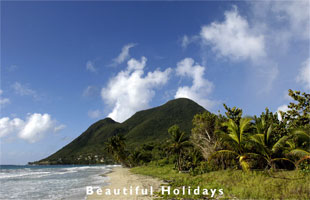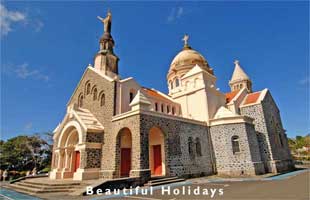Martinique Holidays Guide
The Caribbean

Have you ever walked through the streets of Paris and thought "The only thing missing is music in the air." Well, in Martinique you'll find all the passion and pizazz of Paris, but with music filling the air! Located in the heart of the Caribbean archipelago, Martinique is one of the Windward Islandsof the Lesser Antilles; is has an area of 1,128 km2and it is still a French possession. The eastern coast borders the Atlantic Oceanandthe west coast the Caribbean Sea.The island is dotted with volcanoes, dormant but for the highestat 1,397 metres, Mount Pelée. Volcanic ash from Peléehas painted the beaches of the north in shades of gray and black, in sharp contrast to the ultra-white sands in the south. As part of France, Martinique is a member of the European Union, with the Euro its official currency and French its official language, though many locals also speak Antillean Creole (Créole Martiniquais). Sticking with French custom, many businesses shutfor a long lunch andreopen late in the afternoon.

Map of Martinique
Martinique Holidays Planner
Often called the 'Isle of Flowers,' with botanical gardens tucked here and there in the rugged landscape, Martinique is a 'something for everyone' destination; with an average year-round temperature of 80°, Martinique offers you a "never-ending summer" vacation.Trade winds from the east and northeast deliver a continuous soft breeze that keeps the air fresh.So, if you aredeciding where to go on holiday and are looking for sophisticated pleasures, gastronomic delights, mind-blowing diving sights, and extreme shopping therapy, this is the place for you.The island enjoys a higher standard of living than most other Caribbean countries due in large part to the ongoing support of France, and many French products are easily available, from Chanel to Limoges.

Martinique-Le Morne Larcher – Le Diamant
Martinique Accommodation Guide
Tropical conditions in Martinique havehelped cover the island with vegetation, includinglush tropical forests, savannas, fruits, plants, and flowers, plus the incredible mangrove forests; together this vegetation turns the island into a veritable Garden of Eden. Keep an eye out for tiny lizards called mabouyas and anolis, as well as trigonocephalus snakes, found only on Martinique, and the manicou, an opossum-like mammal found only in the Antilles.

Martinique-Balata Church
You will also see mongoose, but they were brought in to control the snake population. In the north you will find rivers and waterfalls in the dense forests. In the island's central area, the Lamentin Plain leads you to the gentler and geologically older landscape of the south, with its rolling hills, picturesque bays, and hidden coves. In the farthest south area of the island, a prairie of petrified trees provides a unique photographic or sketching opportunity for the artists in your group. Because it is easier to travel and so many beaches and facilities are located throughout this area, the south gets the majority of tourist traffic. Martinique boasts a huge range of accommodations, from comfortable little inns to four-star resorts,plus tourist apartments, rural cottages, country inns, family vacation villages, resort hotels, furnished lodgings, and campgrounds.

Martinique-View Guanadines